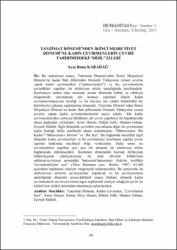| dc.contributor.author | Karadağ, Ayşe Banu | |
| dc.date.accessioned | 2017-06-02T11:54:38Z | |
| dc.date.available | 2017-06-02T11:54:38Z | |
| dc.date.issued | 2013 | |
| dc.identifier.uri | https://hdl.handle.net/20.500.11776/1288 | |
| dc.description.abstract | Bu makalenin amacı, Tanzimat Dönemi?nden İkinci Meşrutiyet Dönemi?ne kadar Batı dillerinden Osmanlı Türkçesine roman çevirisi yapan kadın çevirmenleri (“mütercimeleri”) ve bu çevirmenlerin çevirdikleri yapıtları ön sözler/son sözler tanıklığında incelemektir. İncelemeye neden olan sorunsal, anılan dönemde kültür ve edebiyat dizgemizde yayımlanan söz konusu yapıtlara ilişkin kadın çevirmen/mütercime kimliği ve ön söz/son söz odaklı bütünlüklü bir betimleyici çalışma yapılmamış olmasıdır. Tanzimat Dönemi?nden İkinci Meşrutiyet Dönemi?ne kadar Batı dillerinden Osmanlı Türkçesine roman çevirisi yapan kadın çevirmenlerimizin sayısı altıdır. Altı kadın çevirmenimizden yalnızca dördünün adı çeviri yapıtların ön kapaklarında okura doğrudan verilmiştir: Azize Hanım, Hâlide Edib, Madam Gülnar, Zeyneb Sünbül. İlgili dönemde çevirileri yayımlanan diğer iki çevirmenin kadın kimliği farklı şekillerde okura sunulmuştur: “Mütercimesi: Bir Kadın”/“Mütercime-i Merâm” ve “Bir Kız”. Bu bağlamda öncelikle ilgili dönemin kadın çevirmenleri ve bu çevirmenler tarafından yapılan çeviri yapıtlar hakkında niceliksel bilgi verilecektir. Daha sonra ise çevirmenlerin yapıtları ayrı ayrı ele alınarak ön sözler/son sözler bağlamında irdelenecektir. incelenen dönemdeki kaynak dil/kaynak kültür/kaynak edebiyat/yazar ile erek dil/erek kültür/erek edebiyat/çevirmen arasındaki bakışımlı/bakışımsız ilişkiler özellikle “çevirmen(ler)in sesi” (Theo Hermans (çev. Bulut), 1997: 63-68) açısından toplumsal cinsiyet vurgusuyla irdelenecektir. Bu çerçevede ön sözlerin/son sözlerin çeviriyazıları yapılacak ve bu çeviriyazıların tanıklığında dönemin sosyo-kültürel yapısı dikkate alınarak kadın çevirmenlerin çeviri/çevirmen algısı toplumsal cinsiyet odağıyla çeviri ön sözleri/son sözleri üzerinden okunmaya çalışılacaktır. | en_US |
| dc.description.abstract | This article aims to analyze the woman translators who translated from Western languages into Ottoman Turkish from the Tanzimat to the Second Constitution (II. Meşrutiyet) as well as the works translated by these translators which include their prefaces and epilogues.The problematic motive which led to this analysis is the lack of a comprehensive descriptive study in the books published in our literary and cultural system of the era in question which focuses on the identities of woman translators and the prefaces/epilogues written for their translated books. The number of woman translators who translated from Western languages into Ottoman Turkish from the Tanzimat to the Second Constitution is six. The names of only four woman translators out of six were revealed directly to the reader on the front cover, namely Azize Hanım, Hâlide Edip, Madam Gülnar, and Zeyneb Sünbül. On the other hand, the woman identities of the other two translators, whose translations were published in the mentioned era, were revealed indirectly to the reader in various implicit ways such as “Mütercimesi: Bir Kadın (The Woman Translator: A Woman)”/“Mütercime-i Merâm (The Woman Translator of Merâm)” ve “Bir Kız (A Girl)”. Thus, in this context, some information will be primarily given about the woman translators of the relevant era and subsequently some quantitative information about the books translated by these translators will be shared. Thereafter, the translated works by these translators will be handled individually in order to be investigated in the context of their prefaces and epilogues, respectively. The symmetrical/asymmetrical relations between source language/source culture/source literature/author and target language/target culture/target literature/translator in the period under discussion will be probed especially in terms of the voice of the translator(s) with an emphasis of social gender. Within this framework, the prefaces and epilogues of the books translated by the afore-mentioned woman translators will be transliterated and also the translation/translator perception of the relevant woman translators will be attempted to be read through the prefaces and epilogues of their translations by considering the socio-cultural structure of the era in question with a social gender focus. | en_US |
| dc.language.iso | tur | en_US |
| dc.publisher | Namık Kemal Üniversitesi, Fen-Edebiyat Fakültesi | en_US |
| dc.rights | info:eu-repo/semantics/openAccess | en_US |
| dc.subject | Tanzimat Dönemi | en_US |
| dc.subject | Kadın Çevirmen | en_US |
| dc.subject | “Çevirmenin Sesi” | en_US |
| dc.subject | Azize Hanım | en_US |
| dc.subject | Fatma Âliye Hanım | en_US |
| dc.subject | Hâlide Edib | en_US |
| dc.subject | Madam Gülnar | en_US |
| dc.subject | Zeyneb Sünbül | en_US |
| dc.subject | Tanzimat Period | en_US |
| dc.subject | Woman Translator | en_US |
| dc.subject | The “Translator‟s Voice” | en_US |
| dc.subject | Azize Hanım | en_US |
| dc.subject | Fatma Âliye Hanım | en_US |
| dc.subject | Hâlide Edip | en_US |
| dc.subject | Madam Gülnar | en_US |
| dc.title | TANZİMAT DÖNEMİ’NDEN İKİNCİ MEŞRUTİYET DÖNEMİ’NE KADIN ÇEVİRMENLERİN ÇEVİRİ TARİHİMİZDEKİ “DİŞİL” İZLERİ | en_US |
| dc.title.alternative | THE TRACES OF “FEMINITY” OF WOMAN TRANSLATORS FROM THE TANZIMAT TO THE SECOND CONSTITUTION IN OUR TRANSLATED LITERARY HISTORY | en_US |
| dc.type | article | en_US |
| dc.relation.ispartof | HUMANITAS - Uluslararası Sosyal Bilimler Dergisi | en_US |
| dc.department | Tekirdağ Namık Kemal Üniversitesi Dergileri | en_US |
| dc.authorid | 173865 | en_US |
| dc.identifier.volume | 1 | en_US |
| dc.identifier.issue | 2 | en_US |
| dc.identifier.startpage | 105 | en_US |
| dc.identifier.endpage | 126 | en_US |
| dc.relation.publicationcategory | Makale - Ulusal Hakemli Dergi - Kurum Öğretim Elemanı | en_US |



















